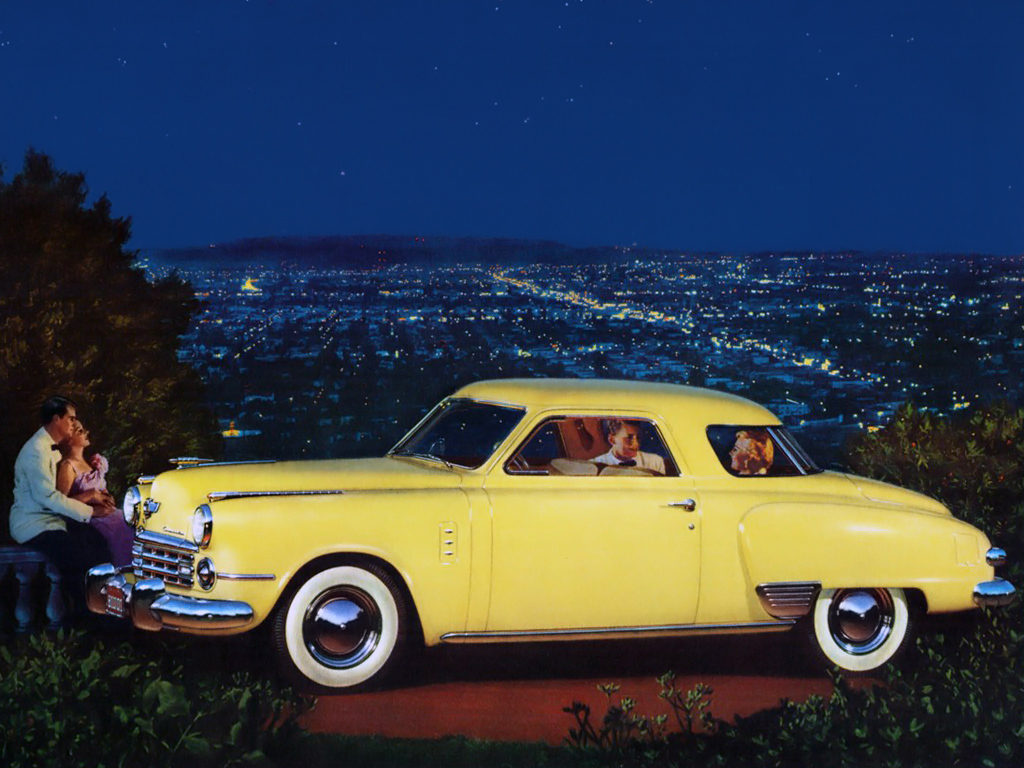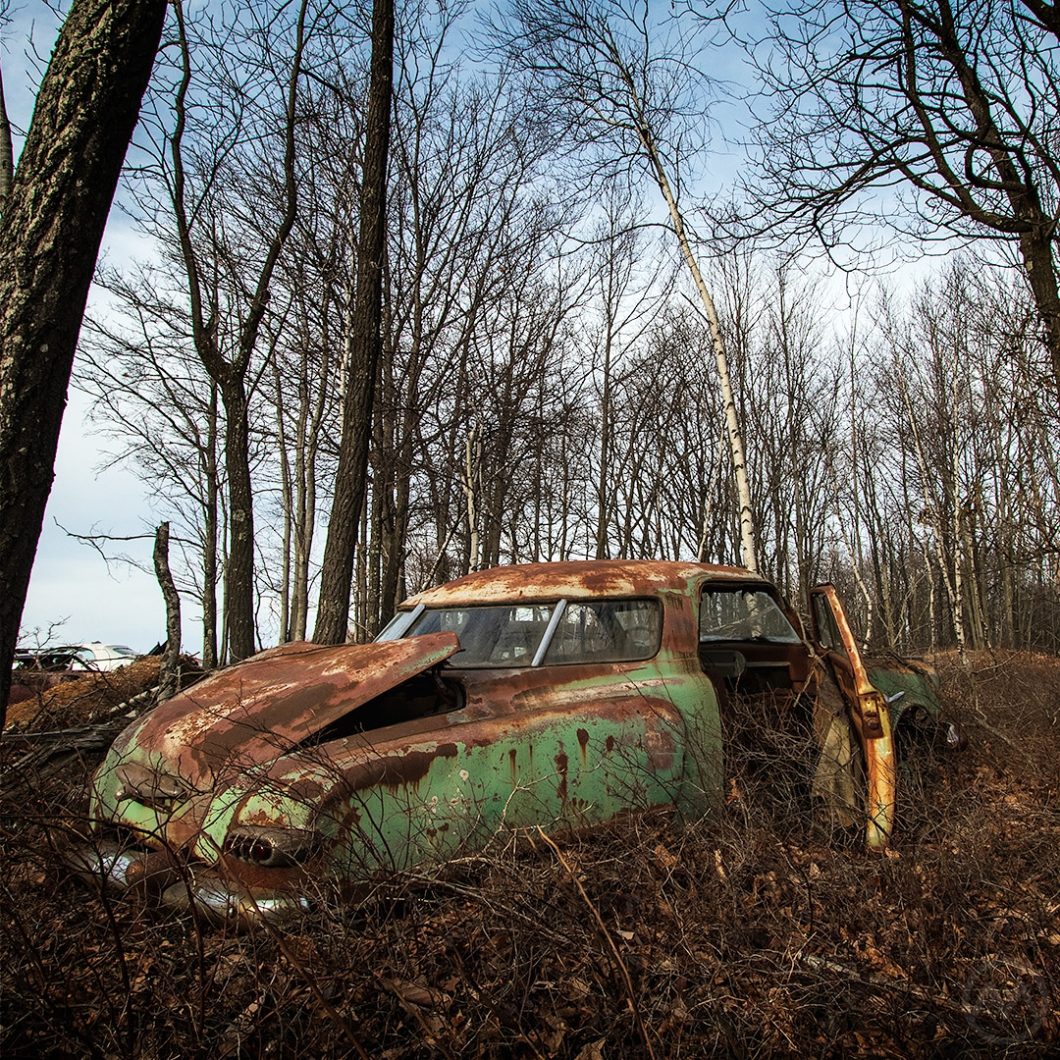“The first by far with a postwar car!” the ads trumpeted. It was pretty much true, although the cars didn’t actually get into customers’ hands until very late in the year and they housed mostly pre-war mechanics.
The ‘47 Studebakers were nevertheless genuinely new and radical in appearance compared to the warmed-over ‘42s on every other lot. Henry Kaiser’s new cars were fast catching up, but Studebaker was an old-school company with nearly 100 years of history.
The most interesting of the new cars was the “Starlight” coupe, with its rakish aircraft-inspired roofline. The ads credited the design to Raymond Loewy & Associates. In one sense, that was true – they were designed by an “associate.” But by 1946 the lead “associate” behind designing the cars – Virgil Exner – was no longer “associated.”
Needless to say, the 1947 Studebakers were the product of considerable “palace intrigue” within both Loewy & Associates and Studebaker itself.
Ray Loewy & Studebaker
Following stylistic (but not commercial) success consulting for Hupmobile, Loewy’s first Studebaker contract had come in 1936. The first models credited to him arrived in 1938. Decades later Studebaker designer Bob Bourke would opine that while Loewy was brilliant at graphic design (and showmanship), he couldn’t style cars. “He was just ridiculous as far as cars were concerned, and he knew it,” Bourke said.
Though the industrial design impresario himself typically claimed the credit, Loewy’s cars were almost universally designed by staffers. In 1938 he’d lured Exner away from GM. At GM, “Ex” had been recruited by Harley Earl and had followed Frank Hershey in styling the 1937-38 Pontiacs.
Exner, in turn, hired Bourke on the recommendation of fellow Loewy staffer Clare Hodgeman. Hodgeman had penned the 1939 Studebaker Champion and Bourke had started designing refrigerators for Sears.
The Postwar Studebakers
As early as the summer of 1940 Exner and Bourke worked on proposals for a new Studebaker, but Loewy and Exner often clashed and the alliance with Studebaker skakey. Arguments were usually mediated by Gordon Buehrig, then working for Loewy.
You may remember Buehrig for his consequential designs of the 1930s – the Cord 810/812 of 1935-36 and many Auburns including the 851/852 Speedster. Buehrig was already a giant but liked Loewy, though reports indicate the feeling wasn’t necessarily mutual. Nevertheless, Loewy and Exner’s relationship was supposedly worse and Buehrig was a buffer between them.
The Studebaker team also featured Vince Gardner, who would do much of the front-end work on the 1947 Champion, and Frank Alhroth, according to Bourke.
With Exner, a fan of Indiana and a Notre Dame alumnus, spending a lot of time in South Bend rather than Loewy’s NYC office, Studebaker engineering VP Roy Cole had Exner work on his own proposals for the new car at home. Cole supposedly thought Loewy was overcharging for his services. Possibly, but compared to the staffing costs of GM, Studebaker was probably getting a bargain.
According to Bourke, Beuhrig was aware of the Exner-Cole collaboration, but Loewy was kept in the dark for fear of sinking the entire contract, but it’s not really clear who knew what.
Loewy Fires Exner
Unbeknownst to Loewy, Cole had Exner present his “basement designs” alongside the Loewy proposals in mid-1944. Studebaker chose Exner’s version and Loewy angrily fired him.
Exner continued working on the ‘47s for Studebaker as an employee, but the cars were publicly credited to the well-known Loewy (and generally to Loewy & Associates). Indeed, Bourke and the other staffers were doing finishing details on them too. Work had not ended when Exner left Loewy’s employ, but it was Exner’s name on the patent drawings.
Ultimately Studebaker wanted to continue using Loewy, so Exner was eventually recommended by Cole first to Ford and then Chrysler’s K.T. Keller – the start of a legendary partnership. Bourke replaced Exner as the leader of Loewy’s “Studebaker studio” and led work on the amazingly sleek 1953 models.
The Fabulous Starlight
The Starlight, with its wrap-around “vista dome” style canopy today evokes perhaps an observation car on a train, as the reference implies. In reality, it was inspired by glassy aircraft cockpits that Exner and many other people had seen regularly during the war.
Opening the back up to light and views ran against the usual “coupe” practices of the 1930s and 1940s, with their big, formal C-pillars. It was light an airy inside instead of cloistered and dark. Hardtops weren’t a thing yet when the Starlight debuted, so it was a very stylish coupe at the time. It was also fundamentally different from other two-door sedans and quite recognizable as a result.
A more formal-looking business coupe and a 2-door sedan – which featured a rear window that resembled the central two windows on the Starlight – were also offered.

Studebaker’s 1942 cars were not new, so it didn’t make sense to really invest in them after the war, hence the drive for a totally new car despite the fact that pre-war cars sold just fine in the “seller’s market” of 1945-49. Nevertheless – public response to the new cars was enthusiastic.
More than 250,000 Studebaker cars and trucks were sold in 1947 and the basic shell continued into 1952. The styling was attributed – with loads of marketing copy – to the well-known Loewy. The same situation would happen at Nash a few years later when Pininfarina got the credit for work actually done in-house. Why? It made for good marketing.
Underneath the cars much was recycled from older designs – particularly the engines. The ‘47 Studebakers came as either the lower-end 112” (284cm) wheelbase Champion with a 169-cid flathead six or the higher-end 119” (302cm) wheelbase Commander with a 226-cid (later 245) six. None were road burners but they were respectable by 1940s standards. A special 123” (313cm) wheelbase Land Cruiser sedan was at the top of the line. Commanders and Land Cruisers were early adopters of the one-piece windshield,
Epilogue
The basic ‘47 body, with a multitude of front and rear changes – most notably the “bullet nose” of 1949-51, ran into 1952, Studebaker’s 100th anniversary year.
Until that final year, when the basic car was now quite old, sales had been on an upward trajectory. The “anniversary” restyled did away with the “bullet nose” look of the 1949-51 cars, but was mostly the same. The only really new thing was a proper hardtop. Designed by Bob Bourke, the “starliner” replaced the aging Starlight, but it looked a great deal like a GM hardtop.
The old 1947-48 Commander Starlight at the top of the page was photographed at Bonner’s Auto Parts in Pennsylvania in late 2019.


Bullet nose design was only in ’50 and ’51. 1950 – the first bullet nose was stude’s best selling year ever.
The 52 introduced (rather crudely) the droop nose of the 53/54 design.
I owned several studies a 53 champion v8 4 door,A 53 star lite coupe 6 cyl then a bought a 1962 GT HAWK manual steering and brakes they were all GREAT CARS